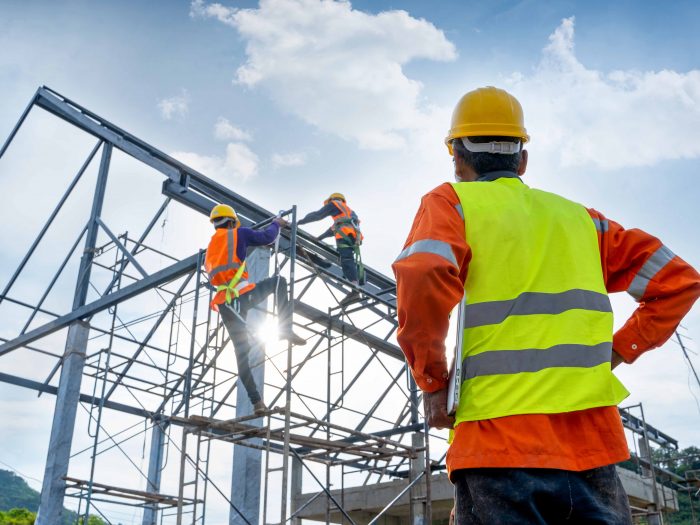4 Ways Video Monitoring Boosts Safety and Efficiency on Construction Sites

Have you ever gotten tongue-tied when someone says, “Say something, you’re on camera!”
Why do people sometimes set up fake cameras to deter mischief? Would a thief rob a bank if they knew they were being recorded?
It’s all the same concept; people act differently when they know they’re being filmed.
The digital age we live in has the power to capture some of our best moments and save them forever, but it also has the potential to capture our worst.
There are seldom industries as collaborative or risk-prone as construction, which is why video monitoring to promote best practices is gaining traction.
The accessibility to cheaper, higher-quality technology is a major reason for this, according to Adrien Robinson, head of construction, Inland Marine & Complex Casualty, The Hartford.
“Cameras are not new but some of the basics of these technologies have vastly improved over the last few years,” said Robinson. “The cost of cameras have decreased rapidly and the quality of the video has improved dramatically … you also have Cloud storage capabilities and artificial intelligence.”
While cost is certainly a factor in management’s decision to forgo video monitoring, the presence of a camera can also relay a message of distrust to employees. However, technology and effective communication between management and employees are highlighting just how effective video monitoring can be in improving efficiency of a job site.
“I think they’re going to be pretty ubiquitous on any job site of reasonable size,” said Robinson.
Here are 4 reasons job site managers are saying ‘Yes’ to cameras, according to construction experts.
1. Promotes Safety
With so many responsibilities on a job site, employees sometimes forget that their own safety is the main priority. With video cameras that can capture work injuries or near misses, it’s easy to go back and show employees what not to do. In addition, if workers know there is a possibility they are being watched, they are more inclined to use best practices.
“They’re not so much using it in real time as opposed to looking backward at a project and observing operational processes and worker behavior, all with the goal of trying to make things on site as safe as possible,” said Thomas Grandmaison, chief broking officer of Aon’s Construction Services Group.
“If you’re able to correct things before they become a habit, perhaps there’s an opportunity to influence claim outcomes.”
When you work on a construction site every day, it’s easy to become used to all of the safety hazards that come with it and, over time, begin to proceed with less caution.
“It’s one thing to say, ‘One of our colleagues had a near miss”. It’s another thing to show people what that near miss looked like and it’s a much more impactful view for the worker when they see how consequential that miss could have been,” added Robinson.
2. Promotes Productivity
For construction site managers, it’s hard to be in every place at once, and therefore it’s hard to run a job with complete efficiency. In the hustle and bustle of the day, it’s sometimes difficult to see where things are overlooked from the perspective of an employee.
Being able to refer to video can help determine where resources should be allocated, and where less assistance is need.
“Construction sites are complex environments,” said Robinson.
“As a foreman, you can’t be everywhere at all times. Think about having the ability to monitor multiple areas of the site at one time, and then they may see something and address that right away, whether it’s a construction, quality, or safety issue. It’s just another mechanism to have another set of eyes around the site and identify some of these ideally pre-losses, and correct them before you have a loss or get a violation.”
3. Lessens the Burden for Subcontractors
Aside from being accountable for their own safety, video documentation can hold workers accountable in an industry as collaborative as construction.
“To me, I think it’s best practices. It’s helping you to substantiate that your work was done correctly,” said David Brockmann, area senior vice president, Gallagher.
“Construction defect claims can be represented and defended in a completely different light if the construction is monitored and documented by video and photographs. If it’s monitored you can show that they did their job right, that it was installed the correct way, and if they’re ever brought into a construction defect claim, they can go back and say, ‘Here’s the video that shows we did our job correctly.’ ”
Having evidence of who did what part of the job can also lessen the burden for subcontractors, and eliminate any need to point fingers.
“The general notion is transparency amongst these parties, regarding how much work was being done, how much time and materials did it take,” said Robinson. “There’s a bunch of these scenarios where just having this evidence can really help the parties agree about what happened.”
4. Assists in the Claims Process
On top of documenting the distribution of the work, video monitoring can also expedite the claims process. In a situation where a job site employed multiple subcontractors, the event of a claim could turn into a game of he-said-she-said.
“It’s pretty difficult to say what happened unless it’s caught on video. A claims adjuster could say, ‘Not only did my client not have anything to do with it, we have the video monitoring to show that my client wasn’t even in the area when the claim occurred,’” said Brockmann.
“A lot of subcontractors are brought into these large claims when one subcontractor does something wrong on the job site, a lot of different subcontractors can be brought in just because of the nature of the contract. If a subcontractor is monitoring their own work and shows they’ve had nothing to do with that side of the construction site where they weren’t even on the construction site, and we have that video to prove it, that goes a long way to helping absolve them from any liability claim.”
Video monitoring is also helpful in resolving injury claims, which otherwise would be the employee’s or witnesses’ word against a claims adjuster.
“A picture could be worth a thousand words but video evidence is worth more than a thousand words, given the rich data information that it provides. You may be able to see the extent a worker was or was not injured in certain situations,” said Robinson.
“Sometimes, having this rich-data information can really expedite that process and it puts all of the cards on the table in certain circumstances and just allows for the dispute to happen faster,” said Robinson.
Communication Is Key
So with all of these assets stemming from video monitoring, why don’t all sites have them? Well, according to the experts, that’s the direction the industry is headed in.
According to Brockmann, when implementing this type of technology, communication with employees is key.
“We’re all monitored when we’re pumping our gas, when we’re at the grocery store, when we’re at the bank, I think that maybe 15 years ago this would have been a tougher sell to an employee than it is now… if you’re upfront and you communicate with an employee, it shouldn’t be a problem,” said Brockmann.
“I think what contractors are really trying to do when they’re considering technology like cameras is; will it have an impact on the outcome of the project? Will it make it safer? More efficient? Will it improve the quality? Those questions are being asked around the cost of it,” added Grandmaison. &













